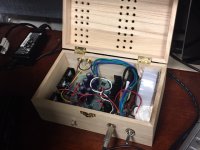Did you even read the book? I find it amusing the amount of confirmation bias going on in audio discussions. People pick and choose what they want to hear and that's all they talk about.
Granted, Toole didn't talk about this a lot. Why? Because it's the absolute basic fundamentals that everyone should know and the book was mainly about more advanced concepts.
But if you look close you will find little gems like this.
"Frequency response is the single most important aspect of the performance of any audio device. If it is wrong, nothing else matters.
...
It is interesting to consider that for as long as anyone in audio can remember, all electronic devices had basically flat frequency responses. No manufacturer of an amplifying device, a storage device, or a music or film distribution medium would even momentarily consider a frequency response specification that was far from what could be drawn with a ruler from some very low frequency to some very high frequency. Yet, when we come to loudspeakers, it is as though we threw away the rule book and suddenly tolerances of +/- 3 db or more are considered acceptable."
Page 372, Chapter 18, section 18.2
He does go on to talk about off axis being important too (as that is one of the most important and not as widely known subjects that this book is about), but let that first quoted sentence sink in for a bit. I could pick out some other quotes that say basically the same thing but don't want to get too wordy here.
While we're at it, let's look at what the book REALLY says.
Toole spends the first half of the book constantly talking about large performance spaces, concert halls, churches, etc, and specifically mentions a primary goal of an entertainment audio system being to reproduce the principle perceptual variables (direct quote, page 33) of those spaces in a domestic (or car) environment.
These variables include direction (localization), distance, timbre, and spaciousness (the two components being apparent source width and listener envelopment).
Interesting to note is that Toole specifically does not care for pinpoint imaging, he much prefers spaciousness, saying this:
"Perhaps because they lack other pleasures of live performances, many audiophiles have come to think that pinpoint localizations are a measure of excellence, so there are opposite points of view. It is a perspective also cultivated by the bulk of popular recordings, many of which are uncomplicated, left, right and center."
The tools he advocates to accomplish these goals of accurately reproducing the principle perceived variables are multi channel systems (at least 5 channels with the center channel being very important) comprised of multi-way speakers with flat frequency response and consistent off axis dispersion (definitely not fullrange drivers as they usually fail pretty miserably in those categories). Controlled reflections and minimal absorption, and most certainly no absorption at the first reflection points as that screws up the IACC (inter aural cross correlation) and timbre of reflections (it absorbs the high frequencies and leaves the low frequencies intact, greatly disrupting the frequency response of the reflection).
He goes on to say that wires and electrical components mostly sound the same unless specifically designed to sound different.
If you actually read the book he argues pretty convincingly that multi channel systems with multi way speakers are much better than full range, for the most part the electronics and cables don't matter, and that audiophiles don't really know what they are doing and prefer a specific sound that is not preferred by the rest of the world.
Some really interesting points here. Thanks for that.
Edit: Is the idea of 'spaciousness' at which Toole aims similar to the audio philosophy underlying many of Bose's designs? (i.e. room filling sound through reflections and so on) If so then this emphasis on 'spaciousness' rather than pinpoint imaging might help explain at least some of the disdain audiophiles express for Bose speakers. Just 'thinking out loud' here.....
Last edited:
While I agree with FR being most important, and off axis response is still important, just not as much as the direct response consider the following:
Take a full range speaker with perfectly flat frequency response, compare it to another full range exhibiting a natural bump at ~1850 Hz and a minor dip at ~3700 Hz. Nothing much, about 1.5 to 2 dB will do. Compare them in a stereo triangle in an anechoic like environment. The second one will win the competition, having a better shot at 3D imaging. At least in the sweet spot.
We have 2 ears after all...
Take a full range speaker with perfectly flat frequency response, compare it to another full range exhibiting a natural bump at ~1850 Hz and a minor dip at ~3700 Hz. Nothing much, about 1.5 to 2 dB will do. Compare them in a stereo triangle in an anechoic like environment. The second one will win the competition, having a better shot at 3D imaging. At least in the sweet spot.
We have 2 ears after all...
(I like a lot of mono) - if I wish to hear "detail" from something dreary like the cd of the Stone's "Exile" on headphones, I use an aural exciter fed into a 3bx expander - like that or not, its a subjective improvement. (should run the exciter in a loop to find out what its boosting/doing at various settings) expanders could use a comeback. An aural exciter in a solid state system will do more wonders than big dollar tranducers or amps.
I ask again, my Chris? I ask because he has never had FE126 and i do all the selling.
Chrisb. I'm not sure if he likes being called "your Chris", but yeah, that's the guy. He absolutely did have 126s and I bought them from him.
Mark Fenlon has a number of pair of EnABLed drivers, and i have been selling Mark Audio since the Jordan J6T. It is a conservative business, it would not be good for him to comment on my drivers.
Yeah, you would think, and yet he did comment on your drivers quite a few times.
I seem to remember a very early post from him where there was a very very brief rocky period between you two before it became clear that you were going to do a massive amount of marketing and distribution for him. IIRC he stated in no uncertain terms that his drivers were very carefully designed and manufactured and did not need any modifications. But since I can't find that old quote, here's a couple others that I did find.
Interestingly, although he did comment on enabl quite a few times, he never did give it the thumbs up. Instead, he remained skeptical, even after auditioning enabl'ed drivers. This is from August 2011, link here - http://www.diyaudio.com/forums/everything-else/194832-disabled-11.html#post2678061
"I'm likely to remain leaning towards the skeptical side of the debate but I try to temper my thinking by acknowledging those guys who've got Enabled and similar drivers and may genuinely believe its an improvement. For some of them, there is a audible difference. They might have a point with a certain amount of justification based on standardised test outcomes from guys like MJK and myself. Are they right if they claim science can't always deliver outcomes, or do their observations have reliable merit? Or do us empiricists see their observations and claims as at best anecdotal, at worst misguided? "
So let's look at that in context. You say it's a conservative business and it wouldn't be smart for him to comment on your drivers, especially since you do a remarkable amount of marketing and distribution for him. And yet there it is. Considering all that, how concerned would he have to be to make those statements? Notice the wording, he firmly places himself in the empiricists camp that claim the subjectivists claims are anecdotal or misguided.
Moving on, what is this "standardized test outcomes from guys like MJK and myself"?
Both MJK and Mark (and others) measured frequency response of raw and enabl'ed drivers and found that the slight mass loading did produce slightly different frequency response. And in Mark's case, he specifically said the audible difference was a REDUCTION OF SPL, a smoothing of tone and a MASKING OF DETAIL.
That isn't a mistake, he said these things several times.
"
Regarding Dave's comments on Enabled and stock drivers, I've had some time recently to test a pair of Enabled CHR-70 drivers and compare them to stock versions.
Quantitative measurement:
The test was carried in an anechoic chamber using LMS (see chart). There's no significant differences in the frequency tracks between the stock and Enabled drivers. The T/S parameters changed little. The only notable difference was the reduced SPL of the Enabled drivers by 1dB. I should add a note of caution. This test should only be viewed as "marginal indicative". For greater reliability, a larger sample of drivers would need to be tested. All the same, there's nothing that significantly stands out from the standard anechoic sweep tests.
Qualitative
I've managed about 4 hours of listening between the stock and Enabled versions in my Hong Kong studio. An additional 3 hour session was held with my HK audio friends, 2 of which are Japanese and very familiar with Fostex.
My my perspective, I enjoyed listening to both stock and Enabled units in similar measure. I liked the Enabled units for their smoothness while I enjoyed the stock units for their clarity. I haven't had time to check the effect of Enabling process on the cone's resonance pattern at the micro-resonance level. However, it is likely that Enabling is applying a subtle damping factor in the mid-high range.
Now comes the really interesting bit. The listening session that included my 2 Japanese audio mates brought something of a division of opinion. For half the group (4 guys), the Enabled drivers weren't favoured over the stock drivers. The damping factor was felt to be too intrusive upon the CHR-70's "character". In particular, 2 recordings got a debate going. Pie Jesu (Requiem Reference recording - Dallas Women's Chorus), the final vote went to the stock drivers for revealing more of the nuances in the soloist's voice. However, the Enabled drivers got the "thumbs up" on Manuela's (Musiclab) rendition of Stand By Me, by way of a silky delivery. "
Link - http://www.diyaudio.com/forums/full-range/150629-how-do-you-score-fe207-chr-70-a.html#post1914015
Here he is saying the same thing again a few posts later.
"Summing the group's preferences, those who were sensitive to, or concentrated on detail least supported Enabled. Conversely, the guys who thought more about tone saw Enabling as a way to smooth of a driver's audible output.
One very important thing that came out from the discussion over the LMS results, is that the whole group agreed that Enabled didn't negatively affect measurable overall performance. This is a good result considering Enabling is, by its very nature a reductive process. "
Link - http://www.diyaudio.com/forums/full-range/150629-how-do-you-score-fe207-chr-70-a-2.html#post1914568
And just so there's no confusion about what he actually meant, here he is saying exactly the same thing 2 years later:
Dave (Planet 10) sent me some Enabled CHR-70's and Fostex drivers a year or so back. Similar to MJK's findings, when I measured these drivers, I found only small changes in the frequency response and a slight increases in mass compared to standard versions. The measured (LMS V4 anechoic) differences the Enabled and standard drivers were marginal.
We followed up with a listening event with several audio guys of various nationalities. From my memory, the group pretty much split into 2 camps. Around half the group liked Enabled. They felt some damping was evident making the music a little smoother in tone. The others felt the Enabling process masked detail and reduced clarity. "
Link - http://www.diyaudio.com/forums/everything-else/194832-disabled-3.html#post2676887
And that's EXACTLY what you would expect when adding a bit of mass. A slightly lower spl level, slightly less breakup (loss of detail) and maybe slightly smoothed tone (frequency response).
For a conservative guy in a conservative business that doesn't sound like a thumbs up.
He also mentioned on SEVERAL occasions that he hoped anyone selling modifications to existing products would do extensive independent blind testing, he even mentioned you specifically in case it wasn't clear what he was talking about.
"I've encouraged you to engage in independent evaluation under controlled conditions in order to better appreciate the changes being produced on the drivers. My worry for you and some others in the audio world is the potential to loose one's objectivity."
Link - http://www.diyaudio.com/forums/full-range/158955-upper-limits-human-hearing-5.html#post2102718
I think that's clear enough that I don't need to post several links of him repeating that through the years.
And that's a pretty concise summation of Mark's thoughts on enabl. Granted he did temper these thoughts with some complimentary statements too, but given the fact that you account for a large chunk of his business that's expected. What's NOT expected is ANY of these quotes above.
Even the very best speakers are crude. They are just the best we have been able to make so far.
That's like saying cars are crude because we haven't invented hovercrafts yet. They are great. Maybe not as measurably perfect as other electronic components, but the best of them are very very good.
Except for the A11 the ones you have gone thru are but a small fraction of what i have tried. You are taking your personal opinions on a smattering of good value to OK speakers and saying they are all like that. You can do the same thing with any genre of speakers and end up with a conclusion that is pretty weak.
I went through a wide variety of very different drivers. Most of them were fully advocated and even sold by you and you and Scott even made box plans for most of them. So don't criticize the selection of drivers that I chose and don't criticize my level of experience. You don't need to have extensive experience with every single model ever made to make some general conclusions. Nothing I'm saying is that surprising, nothing hundreds of experts haven't said before. Why do you think Toole doesn't mention fullrangers in his book? Hint - there's a good reason, it's because they do poorly at all the metrics he values. And the metrics he values are shown to be important by extensive blind testing of trained listeners.
I did say that the frugel-horn 1 had its issues. That is why it was superseded. As to the vocals what amp(s) were you using?
How would that matter? This was an issue of enclosure resonance, not something subtle. I used a variety of tube and SS amps and they all did the same thing. Female vocals were so powerful and resonant that my vent grates rattled. I also have room issues at the same frequencies as the Frugal Horn resonant spikes so maybe that's why other people were able to stand them and I wasn't.
However, if you look at pro reviews of Ed's Horns, 5 out of 6 reviews that I found commented on the colored midbass. And one (Stereophile I think) showed the measurement that showed the problem - the 10 db or so resonant spikes at roughly 110 and 220 hz.
This has nothing at all to do with drivers and amps. It's simply terrible enclosure design.
II have never said that.
I'm not sure who said what, but I'm pretty sure at least Bud said the dots give a boundary disruption layer allowing the waves to "jump off" the cone. If that's really how it works, why wouldn't it work on other surfaces?
Are you specifically saying it won't work on other surfaces? (This much should be clear, just wondering what your opinion on that would be.) Also, do you care to give your version of how it actually works?
I don't think anyone has yet. Put the word jitter where you have DDR. Jitter was around since day 1 and it was people talking about something wrong that encouraged some to come up with a way of measuring it. That took years. No one disputes its importance now.
DDR is an attempt to make more technical and define what people have called detail, inner detail, resolution etc for at least half a century. You are chastising me for trying to push forward a more technical approach to this phenomenon? It has to be talked about and get someone with some real serious measurement chops to get interested and come up with a way of quantifying it.
dave
Audiophiles have been talking about all kinds of crazy stuff for a long time. PRAT is also an attempt to define what people can't define. But it's not because it's indefinable, it's that some people don't know what to look for in measurements that will give the sound that they like.
This is like the whole wire debate. Lifting veils and all kinds of garbage. It's sighted bias and in some cases products that are specifically designed to have irregular LRC properties so that they will actually sound different, so audiophiles can mechanically eq the system without having to add the dreaded eq or tone knobs.
Any sufficient gauge wire of proper conductivity isn't going to make any difference.
DDR (IMO) is just another one of those things that is clearly right there in front of your face, it's already easily defined in terms that are already common vernacular and it's quantifiable and demonstrable in measurements.
Detail is what comes from the 2 - 8 khz range of frequencies. If that range is strong (or has peaks) the level of detail is going to be astounding. That's really about all there is to it. Also imaging will be fantastic for the same reasons.
Last edited:
Some really interesting points here. Thanks for that.
Edit: Is the idea of 'spaciousness' at which Toole aims similar to the audio philosophy underlying many of Bose's designs? (i.e. room filling sound through reflections and so on) If so then this emphasis on 'spaciousness' rather than pinpoint imaging might help explain at least some of the disdain audiophiles express for Bose speakers. Just 'thinking out loud' here.....
I'm not familiar with anything with a Bose label on it. But there are several reasons to disdain Bose.
They are WAY overpriced, WAY overmarketed (and marketed in deceiving ways), they claim old ideas as new inventions, use names (like waveguide) from existing concepts in new ways that have nothing to do with the established definition, and I could go on for days.
But yeah, I think I heard that some Bose stuff was meant to be reflected off walls, in which case it probably definitely would fall into the spaciousness category.
Audiophiles will generally try to listen in the nearfield and kill off all reflections from the front half of the room, especially from the first reflection points. This creates good pinpoint imaging but it's the polar opposite of what Toole advocates and what most people will prefer in a blind test.
There is science to follow though, some first reflections can be bad so you have to know how to set it up properly so it's not just a big mess. Toole talks about damping, reflections, precedence, etc at great length in the book.
Yeah, I don't disagree about Bose being overpriced with more emphasis on marketing than anything else, but I was thinking specifically of some of the early speakers like the 901 and such.I'm not familiar with anything with a Bose label on it. But there are several reasons to disdain Bose.
They are WAY overpriced, WAY overmarketed (and marketed in deceiving ways), they claim old ideas as new inventions, use names (like waveguide) from existing concepts in new ways that have nothing to do with the established definition, and I could go on for days.
But yeah, I think I heard that some Bose stuff was meant to be reflected off walls, in which case it probably definitely would fall into the spaciousness category.
Audiophiles will generally try to listen in the nearfield and kill off all reflections from the front half of the room, especially from the first reflection points. This creates good pinpoint imaging but it's the polar opposite of what Toole advocates and what most people will prefer in a blind test.
There is science to follow though, some first reflections can be bad so you have to know how to set it up properly so it's not just a big mess. Toole talks about damping, reflections, precedence, etc at great length in the book.
So I am making progress. I have located all passive XO components (27uF film caps and 3.6mH inductor + padding resistors for FF85WK). This should give me a 600Hz XO and by moving the FF85WK Dagger housing back and forth, I should be able to get perfect phase/time alignment for transient perfect speaker.
Will assemble it today and see if we can get some sound. I have some nice amps I want try out. Just built this one and got it playing stereo last night.
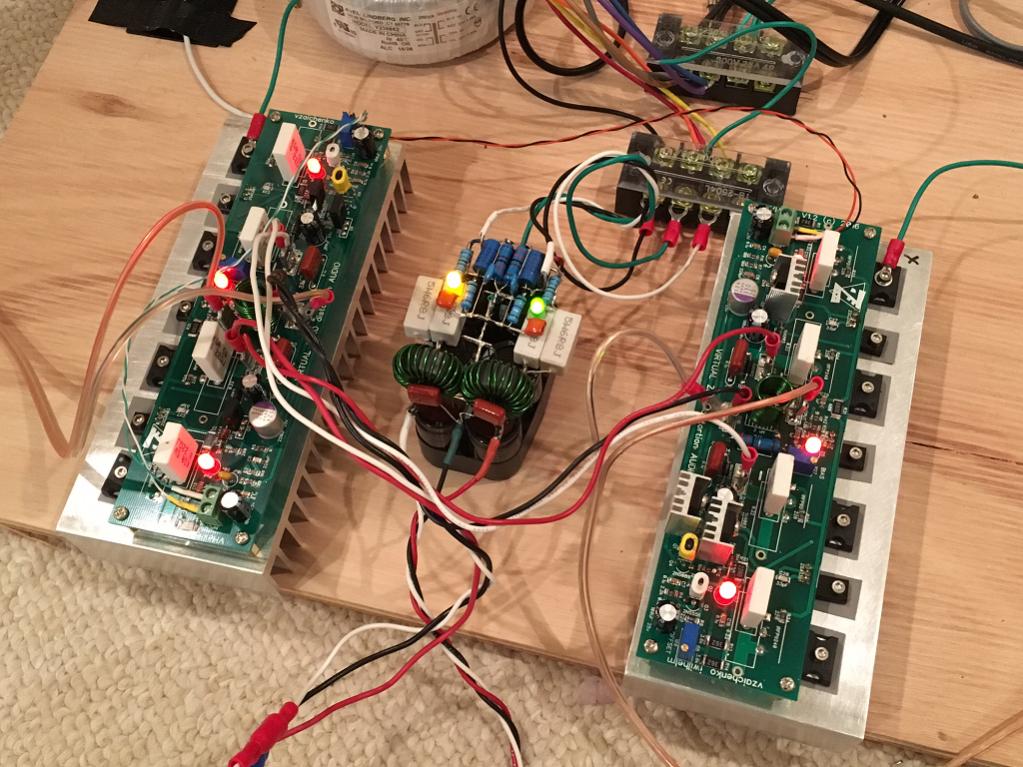
Will assemble it today and see if we can get some sound. I have some nice amps I want try out. Just built this one and got it playing stereo last night.

OK, so what amp is that?
It's a VHex+ dual MOSFET output stage amp by members Vzaichenko and Jwilhelm. Very nice amp - sounds wonderful.
vzaudio
Thread for my build here:
http://www.diyaudio.com/forums/solid-state/286992-irfp240-9240-amplifier-simulated-tina-27.html
If you don't need 100w, this one is rather nice too and much more compact. This is the Apex Audio FX8 (50mm variant) - it uses the very nice Renesas/Hitachi lateral MOSFETs.
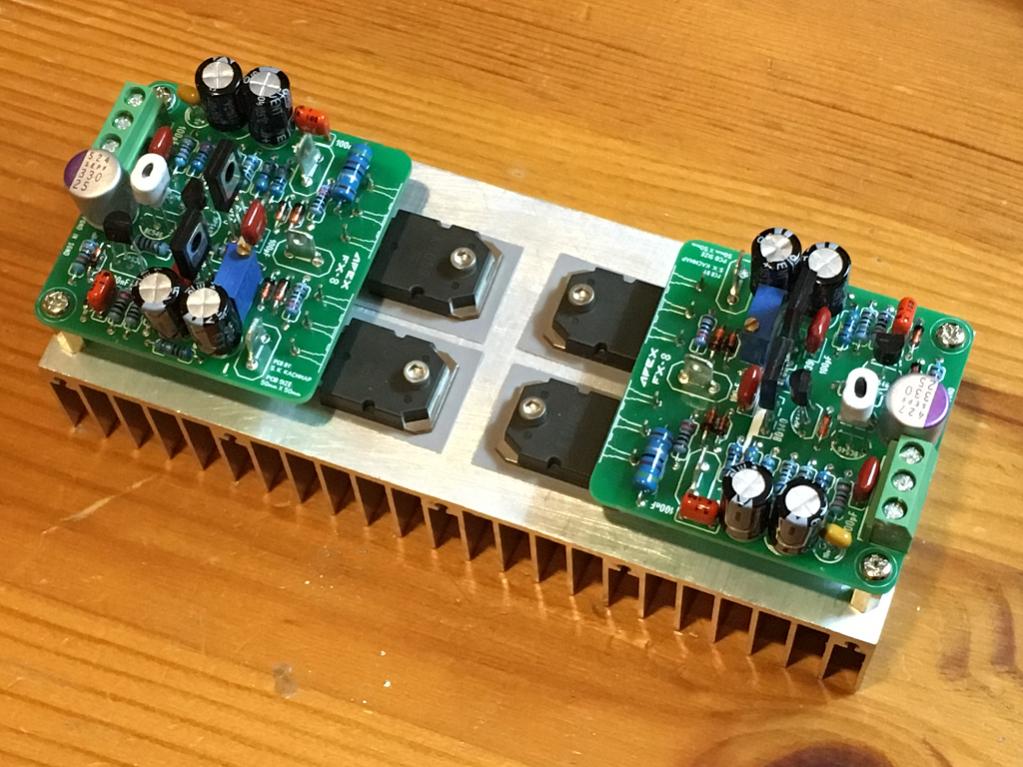
Last edited:
FF85WK & RS225 passive FAST thread
I discuss the new speaker design here:
http://www.diyaudio.com/forums/full-range/292130-ff85wk-rs225-8-passive-fast.html#post4730602
I discuss the new speaker design here:
http://www.diyaudio.com/forums/full-range/292130-ff85wk-rs225-8-passive-fast.html#post4730602
I will say yes am late to the party and yes it might me late in the game but, after reading A lot of post about the Enable measuring going back in forth like a ping pong ball. I am here to say. I have bought quite a few pairs of enabled speakers from Dave. If I didn't think or agree on what bud then Dave is doing I would have look else where. ( Being in hifi for 30 years now). I am glade Dave does what he does best. I said this before to Dave and I will say it again. He is the Michelangelo of speaker painting. He does a wonderful job and goes above and beyond for me. Have I heard the driver's I bought? Well no but I sold most of the pair's I bought but, I have 2 pair's left and ( ( after just buying my amp and pre amp) I will start building and listen from there. Am very blessed I am part of a forum where there are so many veterans who own or know what they are doing in hifi. Thanks again Dave keep up the good work. I know I will be buying again from you soon. Cheers Jeff
Last edited:
If you can't measure it, how do you know it exist? If you hear it? What if you hear it but I don't, does it still exist? If you can't measure it you can't rule out confirmation bias. I'm fine with you believing it sounds nice to you, but you argue that it's a fact, which belies all the science we know.
These discussions are a little funny and pointless to me.
We all hear things differently, whether by choice or age, and debating what sounds best is a little trivial. We all can hear a bad speaker or a bad design from a good one, but when it comes to nitpicking, or splitting hairs, then it's anyone's game.
But, what I don't understand is this:
There has been a lot of ongoing research to loudspeaker designs, and there is a lot of mathematical calculations and measurements involved in the concept of enclosures and drivers. That's science. And everybody here uses it. We rely on its mathematical concepts and equations.
Then, we are supposed to throw out science and believe in some magical voodoo treatments that have a positive impact on the rendering of music, but it can't be measured... So, all that was done in the first place, is now ignored and whimsical, and we have to "feel" it, not measure it. It's only feelings that are affected by the add-on process.
Well, don't hurt my feelings by pushing aside the science which got us here so far. And it's science that will continue to push the boundaries of our knowledge, and not just about acoustics.
So, you guys can go on about your feelings, which are indeed part of the listening experience, but different to each other. I can't measure my feelings compared to yours, so yeah, there's your way out to describe how the drivers are better with or without add-on voodoo.
I'll wait for the science reports.
We all hear things differently, whether by choice or age, and debating what sounds best is a little trivial. We all can hear a bad speaker or a bad design from a good one, but when it comes to nitpicking, or splitting hairs, then it's anyone's game.
But, what I don't understand is this:
There has been a lot of ongoing research to loudspeaker designs, and there is a lot of mathematical calculations and measurements involved in the concept of enclosures and drivers. That's science. And everybody here uses it. We rely on its mathematical concepts and equations.
Then, we are supposed to throw out science and believe in some magical voodoo treatments that have a positive impact on the rendering of music, but it can't be measured... So, all that was done in the first place, is now ignored and whimsical, and we have to "feel" it, not measure it. It's only feelings that are affected by the add-on process.
Well, don't hurt my feelings by pushing aside the science which got us here so far. And it's science that will continue to push the boundaries of our knowledge, and not just about acoustics.
So, you guys can go on about your feelings, which are indeed part of the listening experience, but different to each other. I can't measure my feelings compared to yours, so yeah, there's your way out to describe how the drivers are better with or without add-on voodoo.
I'll wait for the science reports.
Last edited:
There seem to be many on this forum who have the viewpoint:
If you can hear it but not measure it, it does not exist.
If you can hear it but not measure it, it does not exist.
You're right about that, and all that would be needed is to start looking at other places. The differences, if you can hear them, will exist. The trouble is, we can't always rely on what we hear. No matter how hard you try, you can be fooled by your hearing mechanism.
So I guess one way to help resolve this is give you guys sound clips of the pristine and Planet10 eNabled treated drivers (which have more than just cone treatments including basket damping putty) as unlabeled sound clips for several genres. I will do if for two different drivers from each type and let's see if people can correctly identify them. The voting mechanism on a thread only allows for selection of one choice so I will have to figure out how to do this. So I have 4 drivers to test and if we do 2 sound clips ea that will be 8 total to vote on. The vote needs to be applied to ea clip as A or B and we can see how the stats line up.
Now I need suggestions for the two test clips. If we with lossless FLAC as hosted by Byrtt, we need to keep the clips short just to have reasonable download times and not clog up Byrtt's server. Let's say 20 second high res FLAC clips each. I suggest my go to favorites for testing:
Ann Bisson's "September in Montreal" which is perhaps the pinnacle of audio recording/mastering/production sound quality in recent years.
Chick Corea and Paul Motian's "Periscope" from Trilogy album.
I will take other recommendations but you will need to get me a 20 Sec FLAC file source if I don't have it.
I am still refining the passive 1st order XO for the FAST system that will generate the music for recording. Here is what the crossover response looks like. It sounds excellent by the way.
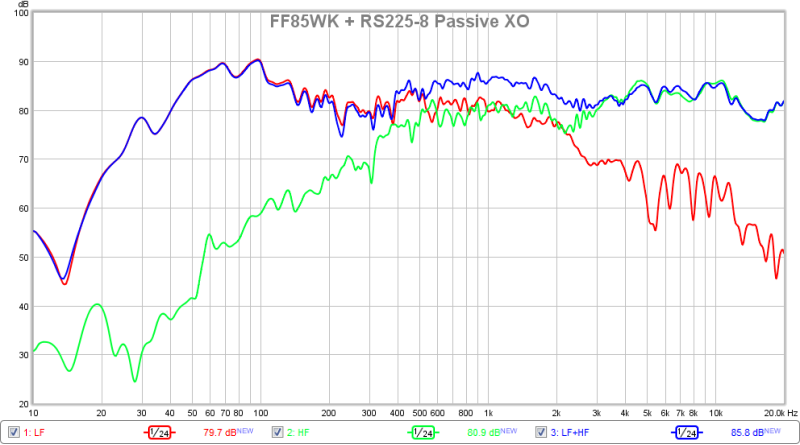
Compared to the predicted response from PCD:
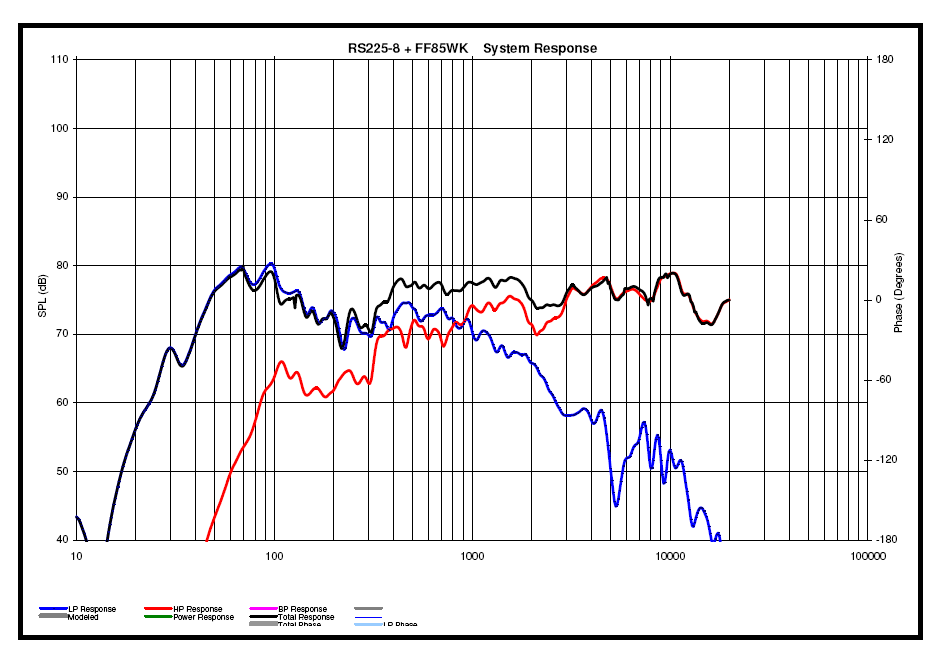
Here is the measured phase:
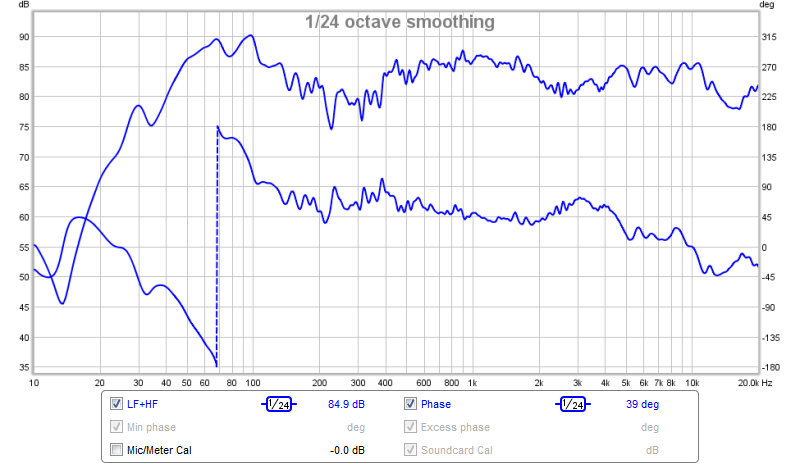
Here is the measured distortion:
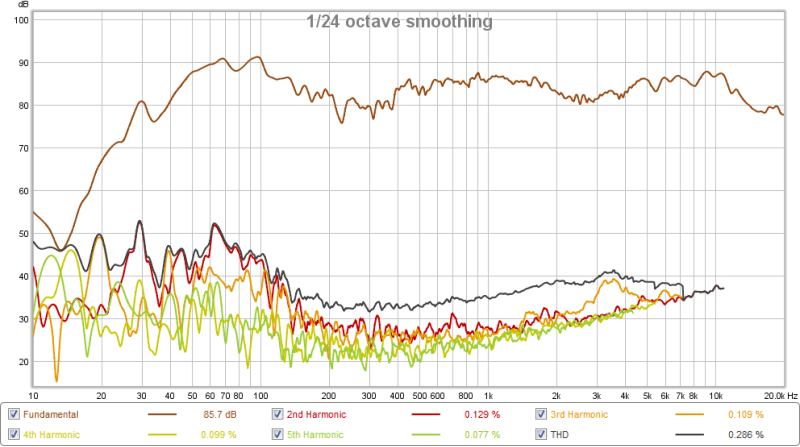
More info here:
http://www.diyaudio.com/forums/full-range/292130-ff85wk-rs225-8-passive-fast.html
Now I need suggestions for the two test clips. If we with lossless FLAC as hosted by Byrtt, we need to keep the clips short just to have reasonable download times and not clog up Byrtt's server. Let's say 20 second high res FLAC clips each. I suggest my go to favorites for testing:
Ann Bisson's "September in Montreal" which is perhaps the pinnacle of audio recording/mastering/production sound quality in recent years.
Chick Corea and Paul Motian's "Periscope" from Trilogy album.
I will take other recommendations but you will need to get me a 20 Sec FLAC file source if I don't have it.
I am still refining the passive 1st order XO for the FAST system that will generate the music for recording. Here is what the crossover response looks like. It sounds excellent by the way.

Compared to the predicted response from PCD:

Here is the measured phase:

Here is the measured distortion:

More info here:
http://www.diyaudio.com/forums/full-range/292130-ff85wk-rs225-8-passive-fast.html
Last edited:
I'm sorry X but I don't see where this has any value at all. Trust me, I have great respect for what you have done and you certainly have knowledge and experience far beyond mine but if you replay a recording of an enabled speaker through an unenabled speaker how could you possibly judge its merit? Am I wrong?
Certainly not the flattest response but it will have personality. I believe there will be a subtle measurable difference between stock and treated. Tweaking drivers is about making a good thing even better. I gave an Eminence 12lta a nose job and prefer the sound. Coating a piezo tweeter with dammar reduced sibilance. But I've coated cones, puttied magnets and baskets, poked holes in dustcaps, stickered, sliced, sprayed, wired directly to the magnet (remember this tweak for the older style Fostex 168z?), placed foam behind the whizzer, and the results were not always an improvement over the stock driver.
That X subjectively enjoys the sound of the treated Fostex FF85 is certainly a good sign that the driver has not been altered enough to sound bad. Perhaps the treatment maximizes what the driver can do?
Thanks for the detailed measurements!
>>> I'm sorry X but I don't see where this has any value at all...
It will be interesting to find out if we can hear any difference at all between treated and stock drivers.
That X subjectively enjoys the sound of the treated Fostex FF85 is certainly a good sign that the driver has not been altered enough to sound bad. Perhaps the treatment maximizes what the driver can do?
Thanks for the detailed measurements!
>>> I'm sorry X but I don't see where this has any value at all...
It will be interesting to find out if we can hear any difference at all between treated and stock drivers.
Last edited:
I'm sorry X but I don't see where this has any value at all. Trust me, I have great respect for what you have done and you certainly have knowledge and experience far beyond mine but if you replay a recording of an enabled speaker through an unenabled speaker how could you possibly judge its merit? Am I wrong?
You should use good headphones and the best signal chain you can afford or have. It's the whole debate of whether or not the enabled driver sound signature can be recorded is the crux of the question. Some claim you have to be in the room. My claim is that if you can hear it, a mic will pick up some sort of measurable difference. And it's the difference we are searching for. Everything is identical from source to DAC to amp to speaker to mic with the only difference being the enabled vs pristine driver. In electrical engineering this is sort of analogous to a very sensitive differential input amplifier (matched LTP transistors). Since everything is the same except the driver - the common mode signal is removed by our brain. In this sense, an earlier suggestion to do a blind ABX test where one just chooses which two sound alike - but that shows distinguishability and not preference. I don't know if they will be indistinguishable or not, but according to some frequency response plots posted by Planet10 - the enable process changes the response a bit. This should be audible if greater than 1dB difference. I am hopeful there will be audible differences. I will leave mic and speaker fixed and only change out driver from baffle. Mechanically and electrically it will all be the same except for the dots and some putty on the basket.
As a side note - for those of you who have headphones and simply plug them into your laptop - try getting a JLH class A headphone amp ($20 kit). It makes a *world* of difference in articulation, bass response, clarity, and transparency. I hear things that I did not hear before. Almost like the headamp gave the headphones more "DDR"🙂
Kit for headamp:
Online Shop 2016 NEW JLH HOOD1969 Class A Headphone Amplifier PRE AMP KIT DIY|Aliexpress Mobile
Boxed and ready to use:
Online Shop Finished HIFI JLH HOOD1969 Class A headphone amplifier 110V/220V|Aliexpress Mobile
Headphones are a perfect application for class A because the SQ difference is substantial and the heat generated is not excessive.
Here is mine in simple wooden box:
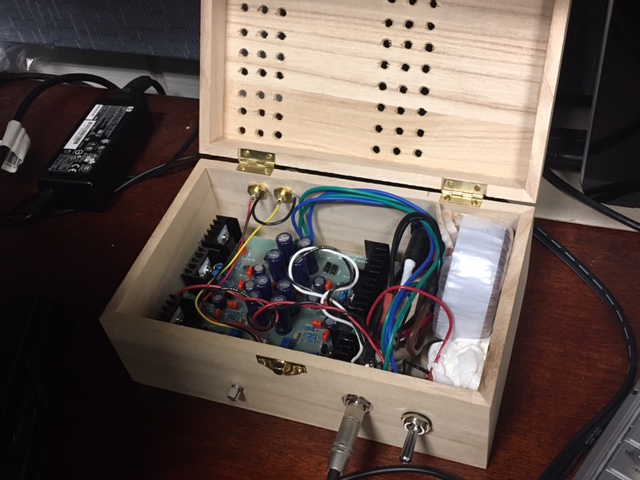
Attachments
Last edited:
My claim is that if you can hear it, a mic will pick up some sort of measurable difference.
Yes.
But how do you know if the difference, (suppose there are any), is because of Enabling/dampening or simply the factory difference between 2 separate pair of drivers?
The only way to know that is to use the same pair before mods and after in the exact same controlled environment, Yes?
- Status
- Not open for further replies.
- Home
- Loudspeakers
- Full Range
- Planet 10 measured improvements? FF85wk
